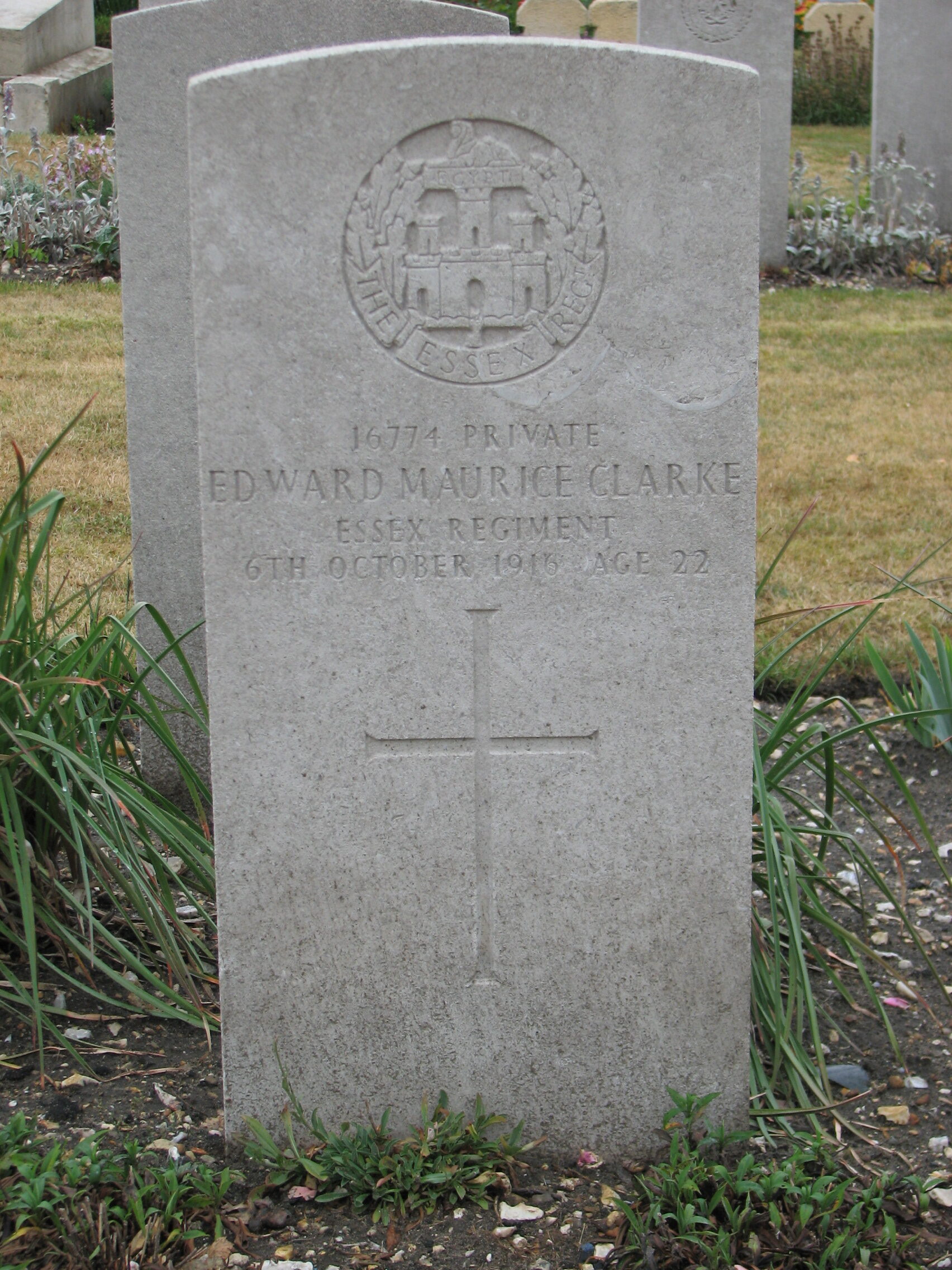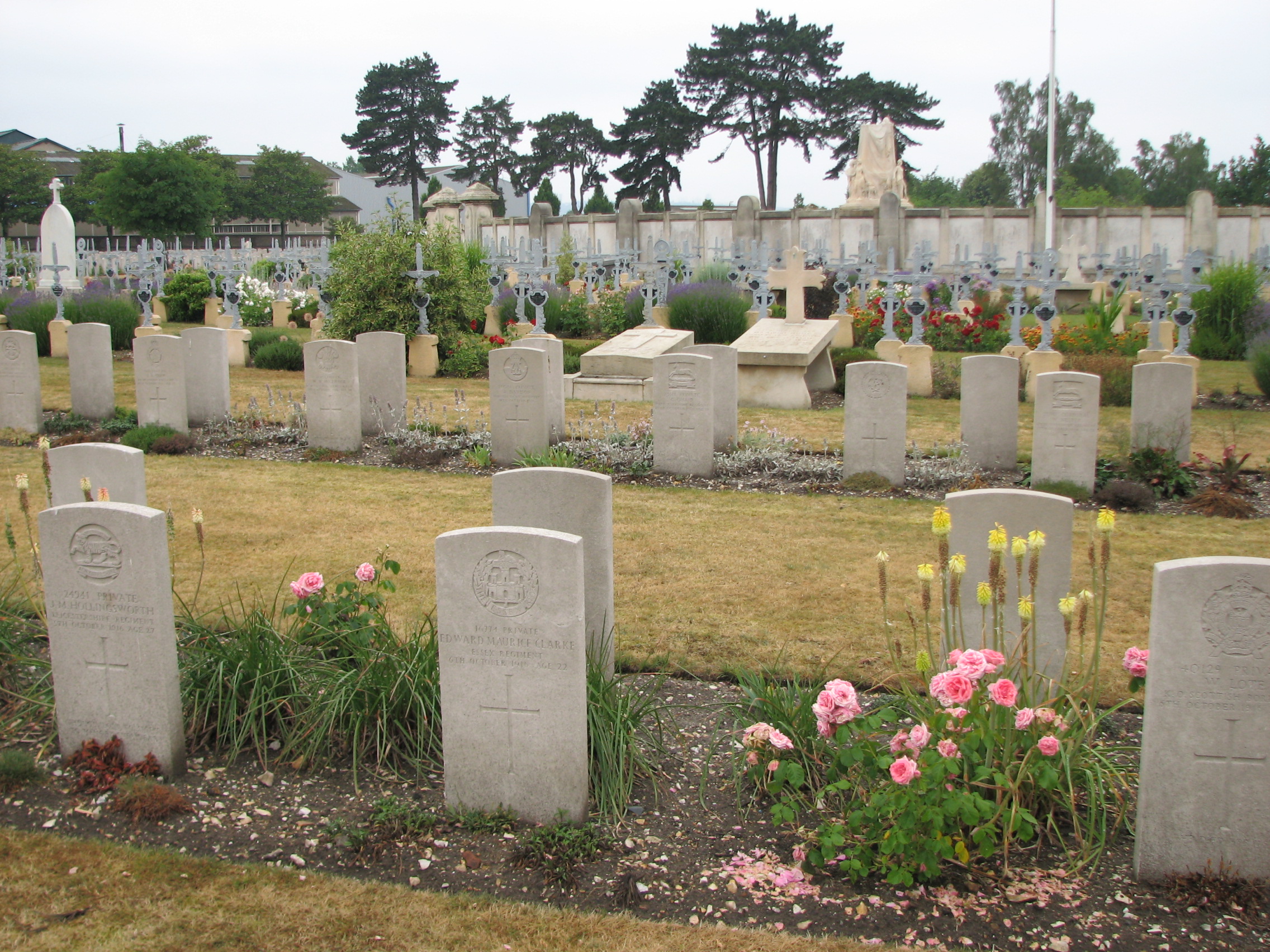Edward Clarke (1894 - 1916)
Brother of Felix Clarke. Edward served on the Western Front, initially with the 2nd Battalion of the Essex Regiment before later being transferred to the Regiment’s 11th Battalion. Edward was seriously wounded during the Battle of the Somme and died in hospital, shortly afterwards.
- 19
- Died in the Great War
- 51.968886, 1.024217
Details
| Name: | Edward Maurice Clarke |
| Service: | British Army |
| Unit: | 11th Battalion, Essex Regiment |
| Regimental Number: | 16774 |
| Rank: | Private |
| Date of Death: | 6th October 1916 |
| Age: | 22 |
| Buried: | Plot B, Row 15, Grave 2, St. Sever Cemetery, Rouen, France |
Family Background and Early Life
Edward Maurice Clarke was born on 28th July 1894 in East Bergholt, most likely in the family home at Burnt Oak. His parents Isaac and Emmeline Clark had moved to Burnt Oak in the early 1890’s having previously lived in Bridge Cottage at Flatford since they first came to East Bergholt in 1876.
Isaac, who was originally from Lawford was a Miller by trade. He had married Emmeline Dorman from Little Oakley in 1872, and together they would have 12 children. Edward was their youngest child, and by the time of his birth many of his older siblings had already left the family home.
Edward started at the village school at Burnt Oak in September 1897. 1 One of Edward’s fellow pupils who started School the same day as him was Hugh Salmon, who lived near the “Hare and Hounds”. Private Hugh Salmon, of the 10th Battalion of the Essex Regiment was killed in action on 21 October 1916, during the Battle of the Somme. Hugh has no known grave, and is commemorated on the Thiepval Memorial. Edward remained a pupil at the school until July 1908, leaving 3 days after his fourteenth birthday.
After he left school, Edward found employment as a Carter, possibly building on his father’s knowledge and contacts in the Milling trade. Isaac Clarke died in 1910, at the age of 64.
Joining Up
In the first week of 1915, Edward volunteered to join the Essex Regiment, at Colchester. After completion of his Basic Training, Edward was sent to join the Regiment’s 2nd Battalion which had been in France as part of the British Expeditionary Force since August 1914.
The 2nd was a pre-war Battalion, and had been one of the first units sent to France in August 1914. Since then, it had suffered heavy losses and by the time that Edward joined the Battalions ranks also included a large number of “hostilities only” volunteers.
Edward disembarked in France on 14th April, and joined the Battalion near the Belgian town of Ypres, shortly afterwards. On the evening of 22nd April 1915, the Germans launched an offensive to the northwest of Ypres, marking the start of what is now called the Second Battle of Ypres. This was one of the first uses of poison gas as a weapon, and it enabled the Germans to break through the Allied line.
For a time the situation was critical for the British and French, and troops were hurried to the front in an attempt to stem the German advance. One of these units was the 2nd Essex.
In the first three weeks of May, the Battalion was heavily engaged in the fighting to defend Ypres, and were subjected to heavy artillery fire and gas attacks. The Battle officially ended on 25th May, and by the time the 2nd Essex came out of the line at the end of the month, they had suffered 655 casualties: 112 killed, 293 wounded and 250 missing. Many of the wounded and missing had been gassed. Edward was amongst the wounded. 2 One of the other 2nd Essex men wounded in the Battle was Lance Corporal Algernon Armitage, from Holly Cottages at East End. Algernon succumbed to his wounds on 26th June 1915, aged 30. He is buried in Boulogne Eastern Cemetery.
Posted to 11th Battalion
Unfortunately, Edward’s Service Record does not survive so we do not know the exact dates of certain key events in his life as a soldier. One of these is the date that he was transferred from the Regiment’s 2nd Battalion to its 11th Battalion.
The most likely time for this to have occurred was after Edward returned to duty, following recovery from his wounds. If this in fact was the case, then it is quite possible that he had joined the 11th before they first left England for France, at the end of August 1915. 3 The 11th Battalion of the Essex Regiment, was raised shortly after the outbreak of war, specifically for some of the large numbers of men who had volunteered for the Army in the late summer and autumn of 1914, following response to Lord Kitchener’s call.
The Battalion’s first major engagement took place less than a month after arriving in France, during the Battle of Loos. The regimental history states “The Battalion, in its first encounter, suffered the loss of 18 officers and 353 other ranks, but they had the distinction, with the 2nd Welch, of being shown upon a map in the Official History of the War as having reached their objective, even though they could not hold it.”
In October, the Battalion was moved north, to the Ypres Salient, where they would remain until the end of late July of 1916. Even when a battalion was not engaged in a major battle and was in a so-called quiet sector, life at the front was extremely hazardous, and casualties were still commonplace.
Three months after Edward was wounded, one of his elder brothers Felix was killed when the ship on which he was serving, was sunk by a German U Boat, in the seas off Norway. 4 Able Seaman Felix William Clarke, of the Royal Navy. Felix was killed during the sinking of H.M.S. India on 8th August 1915, aged 37, and is now buried in Fredrikstad Military Cemetery, Norway.
It is certain that Edward was serving with the 11th Essex by February 1916, at the very latest. In the company of another East Bergholt man serving with the Battalion, Henry Moss 5 Sergeant Henry Moss survived the War. In November 1916, he was awarded the Distinguished Conduct Medal for conspicuous gallantry in action, including rescuing a wounded man under very heavy fire. When Henry returned to Talbot House later in the War, he sought out the entry that Edward had made in the Visitor’s Book on their earlier visit, and wrote “RIP” next to it. – he visited Talbot House in Poperinghe and signed the Visitors Book. 6 During the Great War, Poperinghe (or Poperinge in Dutch) “was part of unoccupied Belgium. Away from the turmoil of battle in the Ypres Salient, the town became the nerve centre of the British sector. In the heart of this bustling town, the Army chaplains Neville Talbot and Philip “Tubby” Clayton opened a club. From December 1915 onwards, and for more than three years, the House provided rest and recreation to all soldiers coming in, regardless of their rank.” Taken from the Talbot House Museum website.
Other men from East Bergholt who served with the 11th Essex at this time were Abram Dale, 7 Private Abram Dale died of wounds on 26th May 1918, aged 23 and is buried in the Esquelbecq Military Cemetery, France. from Box Iron and Arthur Tatum 8 Private Arthur Tatum died of wounds on 9th February 1919, aged 22 and is buried in East Bergholt Cemetery. from near the “Hare and Hounds”.
The Battle of the Somme
After spending nine months in or around the Ypres Salient, on 3rd August 1916 the 11th Essex left their billets and moved to the Somme sector. The great Anglo-French offensive now called the Battles of the Somme had been raging since 1st July, and the Battalion were to join the British forces engaged in that struggle.
The Battalion manned the trenches in the Ancre Valley for a short period in August, and the following month they were involved in heavy fighting in between the villages of Ginchy and Lesboeufs.
At some point in this fighting – probably whilst the 11th were in front of Lesboeufs between 21 and 29 September, Edward was seriously wounded. He was evacuated from the front and was admitted to No 6 General Hospital at Rouen, in Normandy. 9 This was one of several Base Hospitals located in Rouen. Most of the Base Hospitals were located near the Army’s main bases which were close to the coast, far from the front, and with easy access to ports in order to permit wounded to be transported back to the U.K. There, Edward succumbed to his wounds on 6th October 1916.
Edward was buried in the communal cemetery of St. Sever in Rouen, where he rests to this day.
Copyright © Mark Ashmore, 2024
- 19
- Died in the Great War
- 51.968886, 1.024217



